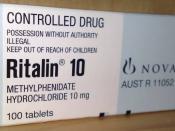She was sitting in class trying her hardest to listen but the smallest movement by a classmate would distract her. She had a lot on her mind, most of it unimportant and idiotic but still it distracted her from what she needed to be doing. When the teacher told the class to pull out a paper that was given out last class, she just sat there looking around. She hadn't been there last class because she lost track of her days and time. She had a paper due in her next class that was nowhere near done and just now, she began to feel overwhelmed. For some this seems like just an excuse, for others, an amusing story, but for those with Attention Deficit Disorder (ADD) or Attention Deficit and Hyperactivity Disorder (ADHD), it's the way of life.
"...ADHD is the most common behavioral disorder of childhood. It occurs in four to eight percent of boys and two to five percent of girls.
It was first described in the early part of this century and was initially thought to be the result of some type of brain damage, thus the name minimal brain damage, or MBD. By the 1960s, it had become clear that only a minority of children had any evidence of brain damage and the name was changed to 'hyperkinetic syndrome' or 'hyperactivity' (Comings, 1992)." "For decades, psychologists have tracked ADD and ADHD in children, who make up more than 95 percent of all cases. However, recent research has shown that while hyperactivity often diminishes with age, the other hallmark symptom--inattention and impulsivity--can persist into adulthood and pose lifelong challenges (Ards, 2004)." Often, ADD goes unnoticed in adults and adolescents because the symptoms relate so closely to those of stress and depression. In the case of depression, the...



Quite Informative
Thank you for writing this essay. I've always wondered if I had a slight case of this, and reading your report has helped me learn of some facts that I hadn't known about before.
This is definitely a well structured essay, and the introduction was different, but I think it worked well.
1 out of 1 people found this comment useful.